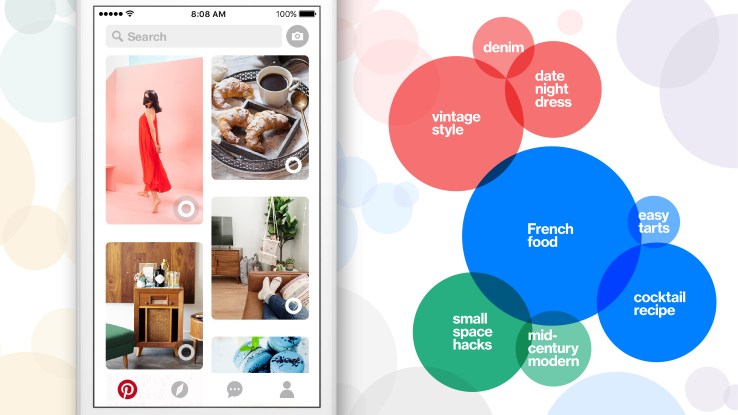Pinterest opens up more than 5,000 interests for advertiser targeting through its Taste Graph

Pinterest builds itself around visual discovery — the idea that you can come to the site or app, see something you like, and immediately dive down a rabbit hole. The company has built an extensive suite of tools internally to figure out which rabbit hole to divert users to, and now it’s opening up some of that knowledge to advertisers.
Pinterest said today that it’s unlocking more than 5,000 interests that advertisers can now target against using what the company is calling its “Taste Graph.” That’s Pinterest’s nomenclature for its system that is able to figure out not only what users like, but also how what they like changes over time — such as topics that are suddenly interesting, and ideas that decay into irrelevance. It’s another move as Pinterest tries to position itself as an alternative to big platforms with an entirely unique data set based on its user behavior.
“One of the biggest difference with the Taste Graph compared to what we were doing before was really diving into understanding the nuances of how we relate Pinners to Interests based on the recency and frequency of their engagement,” John Milinovich, product manager for the Taste Graph, said. “We’re much smarter about how we decay interests from a user’s taste profile so that we can better personalize their recommendations. So, if you haven’t pinned about your wedding in a while, you will stop seeing wedding content.”
The Taste Graph has been around for a while and has historically been used for organic content, Milinovich said. It’ll be another compliment to Pinterest’s increasing efforts to hunt down users that are interested in products at specific moments in their lives. Earlier this year, Pinterest said it would also bring its visual search technology to its ads as it continues to try to build a differentiated advertising product.
Pinterest started exploring how to utilize the Taste Graph to improve its advertising products in 2017, which would help advertisers access users with a much more specific set of interests. The better the targeting, the more likely a user is likely to engage with an ad — which means the better the return for both the advertiser and Pinterest. Better-targeted ads are also probably less likely to have a negative impact on the user experience, which is table stakes going up against massive advertisers which have tons of data on how to best target their ads.
Pinterest executives emphasize that their hope is to build an advertising business that not only touches users at each point of their buying lifecycle but demonstrate to brands that the ads they showed to them at the very beginning of their awareness led to a conversion. That conversion could have happened months later, but in the end, it was still a conversion — and it’s a problem that traditional awareness advertising formats like TV have often struggled with. The company hopes that providing that attribution provides a strong enough selling point to grab ad spend away from bigger, more reliable platforms by offering a unique user base.